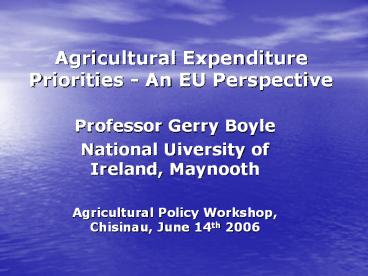Agricultural Expenditure Priorities An EU Perspective - PowerPoint PPT Presentation
1 / 20
Title:
Agricultural Expenditure Priorities An EU Perspective
Description:
Lessons from EU and Irish experience. EU profile of and trends in ... Silage fodder. 44. Milking machine technology. 9. Potato breeding. Concluding remarks ... – PowerPoint PPT presentation
Number of Views:48
Avg rating:3.0/5.0
Title: Agricultural Expenditure Priorities An EU Perspective
1
Agricultural Expenditure Priorities - An EU
Perspective
- Professor Gerry Boyle
- National Uiversity of Ireland, Maynooth
- Agricultural Policy Workshop, Chisinau, June 14th
2006
2
Outline of presentation
- Lessons from EU and Irish experience
- EU profile of and trends in agricultural
expenditure - The benefits of strategic public expenditure
policies
3
Lessons from EU and Irish experience
- Agricultural policies only play a (small) part in
the enhancement of growth capacity - Sound macroeconomic, public finance, public
infrastructure, regulatory and competition
policies, etc. are more important - Producer subsidies will not generate sustainable
growth a costly lesson learned by the EU - Moldova can avoid the errors of the EU (and
others) by progressively eliminating such
subsidies
4
Structure of EU agricultural expenditure
- Producer Supports supports that are received
directly by producers - General Services Supports supports that are
received indirectly by producers
5
Components of producer supports
- Market price supports (MPS) transfers from
consumers via market interference - Output payments
- Area planted/animal numbers
- Historical entitlements NEW to EU SAPS
- Input use Input constraints
- Farm income payments
- Miscellaneous
- Note items 2-7 are funded via transfers from
taxpayers
6
Components of general services supports
- Research and development (RD)
- Agricultural education
- Inspection services
- Infrastructure
- Marketing and promotion
- Public stockholding
- Miscellaneous
- Note these items are typically funded via
taxpayer transfers but may also be funded via
producer levies (e.g. RD)
7
Broad trends in EU agricultural supports
8
Features of broad EU trends in agricultural
expenditure
- Overall tranfers to sector declining
significantly in relative terms - Major shift in structure of Producer Supports
from consumer to taxpayer transfers support now
more transparent and politically sensitive - Major shift in structure of Producer Supports
from Market Supports to other forms - Stable trend in General Services Supports
9
Details of EU PSE trends PSE
10
Features of EU PSE trends
- Shift from highly market-distorting policies to
less market-distorting area and animal based
payments partial decoupling - Single Area Payment Supports (SAPS) will grow
substantially in relative terms full decoupling - SAPS to decline in absolute terms their
rationale lies outside of realm of agricultural
policy (environment and social policies)
11
Details of EU general service supports total
12
Features of EU general service supports trends
- A third of EU general service supports now
accounted for by expenditures on marketing and
promotion - Big shifts towards increasing share of general
services in respect of RD, agricultural
education, and infrastructure - Big decline in expenditure on public stockholding
13
Key messages for Moldova
- Moldova should not repeat the costly lessons of
the EU but - Moldova is increasing producer supports when EU
is decreasing such supports - Moldova producer supports are highly coupled to
production activity whereas EU supports are
decoupled - Moldova discriminates against smaller producers
whereas EU supports attempt to be progressive - Moldova supports eligibility criteria are not
sufficiently transparent (e.g. tractor subsidies)
unlike EU
14
Strategically driven public expenditure policies
- Taxpayer resources must be used where they create
the greatest impact on economy-wide growth - Public expenditure should not substitute for
private expenditure - Public expenditure must address clear market
failures, e.g. provision of public goods/services
(RD, education, etc.) address externalities - Producer subsidies do not address market failures
and inhibit the sustainable enhancement of growth
15
The evidence supports more spending on general
services
- Compelling evidence from a recent World Bank
study by Allcot et al - a reduction in the share of producer
subidies in rural expenditures by 1 standard
deviation can increase agricultural GDP per
capita by 5 - Example RD can general substantial returns
16
International estimates of internal rates of
return to agr. RD
17
Well managed RD investment can pay handsomely
- Typically the rates of return to well managed RD
activities fall in the range 40-50 - This level of return is 8 to 10 times higher than
what might be considered an acceptable return
on ordinary capital investment - The Irish experience indicates broadly similar
findings across diverse research areas
18
Rates of return for some Irish agricultural
research activities
19
Concluding remarks
- EU and OECD generally trends in agricultural
policy expenditure indicate a growing share of
General Service Supports in total support - The evidence on the potential impact of this
structural shift in terms of achieving
sustainable improvements in rural incomes is
compelling - The Government of Moldova should give very
serious consideration to a similar structural
shift in its agricultural spending policies
20
Concluding remarks contd.
- But caution needed just because some policies
have the potential to be highly productive (e.g.
RD, education,etc.) very careful evaluation is
required before additional resources are
committed - A complete revamp of the Modova system of public
expenditure planning, management and evaluation
is needed to accompany the proposed structural
shift in spending priorities - Thank you































